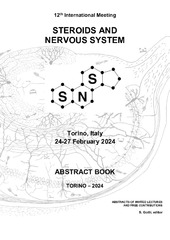Приказ основних података о документу
Hypothalamic-Pituitary-Ovarian Axis Is Affected in Dark Agouti Rats With Experimental Autoimmune Encephalomyelitis
| dc.contributor | Gotti, Stefano | |
| dc.creator | Milošević, Ana | |
| dc.creator | Janjić, Marija | |
| dc.creator | Lavrnja, Irena | |
| dc.creator | Savić, Danijela | |
| dc.creator | Milošević, Katarina | |
| dc.creator | Bjelobaba, Ivana | |
| dc.date.accessioned | 2024-03-11T10:06:01Z | |
| dc.date.available | 2024-03-11T10:06:01Z | |
| dc.date.issued | 2024 | |
| dc.identifier.uri | https://www.neurosteroids.unito.it/home-page | |
| dc.identifier.uri | http://radar.ibiss.bg.ac.rs/handle/123456789/6583 | |
| dc.description.abstract | Experimental autoimmune encephalomyelitis (EAE) is the most commonly used animal model of multiple sclerosis (MS) [1], which is a chronic neurodegenerative disease of the central nervous system characterized with neuroinflammation and demyelination. MS affects over 2 million people worldwide, mostly during the reproductive age, and it is far more prevalent in women than in men [3]. Because fluctuations in sex hormone levels during puberty, menarche, pregnancy, or menopause may impact the prevalence and outcome of MS [2], we have undertaken efforts to elucidate the status of female hypothalamic-pituitary-gonadal (HPG) axis during EAE. EAE was induced by active immunization in 9-12-week-old female rats of Dark Agouti strain. Disease symptoms, body weight changes and estrous cycle stages were monitored daily. The animals were sacrificed at the onset of symptoms (Onset), at the peak of the disease (Peak) and after the complete cessation of all symptoms (End). Non-immunized, age-matched female rats were used as the Control group. All animals were sacrificed in the diestrus stage of the estrous cycle. Luteinizing hormone (LH) and gonadal steroid levels were measured, and the expression of relevant genes was assessed in hypothalamic, pituitary and ovarian tissue. In the hypothalamic tissue, a downregulation in Kiss1 expression was observed, while Gnrh1 expression remained unaffected during the symptomatic phase of EAE. This was accompanied by several-fold induction of the expression of astrocytes and microglia/macrophages inflammatory markers – Gfap, Cd68, Ccl2, and Il1b. In the anterior pituitary tissue, a downregulation in the expression of Gnrhr, Lhb and Cga was recorded, along with significantly decreased LH levels in the circulation, at the peak of EAE. Nevertheless, pituitary remained responsive to GnRH analogue challenge during the peak of the disease. Pituitary Fshb was upregulated during onset and peak of EAE. An arrest in the estrous cycle was registered, at the state of diestrus. Histological analysis of ovaries showed maintenance of corpora lutea and increased number of atretic follicles at the peak of the disease. In the ovarian tissue, steroidogenic machinery components – StAR, CYP11A1 and 3β-HSD, were upregulated at the gene and/or protein level. Accordingly, progesterone levels were increased during the symptomatic phase of EAE, both in circulation and in ovarian tissue. CYP17A1 gene and protein as well as testosterone and estradiol levels in the ovary were significantly decreased. Interestingly, circulating testosterone levels were slightly increased while circulating estradiol remained unchanged during EAE. Overall, our results suggest that the changes in the function of the female reproductive axis during EAE are due to a disruption of hypothalamic regulation, probably caused by neuroinflammation. The arrest in the diestrus phase of the estrous cycle, together with changes in ovarian steroidogenesis, contributes to a pseudopregnancy-like state in female rats, which could represent an adaptation to the inflammatory process and implies a temporary reduction in reproductive capacity to allow the system to fight the disease. Furthermore, our results point to the importance of investigating the bidirectional relationship between hormonal status and EAE/MS. This may also have an impact in the clinical practice, as the approval of sex steroids as adjuvant therapy for MS could be accelerated if they were prescribed only after careful monitoring of the individual patient’s HPG axis status. | sr |
| dc.language.iso | en | sr |
| dc.publisher | Milan: Dipartimento di Scienze Farmacologiche e Biomolecolari | sr |
| dc.relation | info:eu-repo/grantAgreement/MESTD/inst-2020/200007/RS// | sr |
| dc.rights | openAccess | sr |
| dc.source | Abstract of individual lectures and free contributions: 12th International Meeting Steroids and Nervous System; 2024 Feb 24-27; Torino, Italy | sr |
| dc.title | Hypothalamic-Pituitary-Ovarian Axis Is Affected in Dark Agouti Rats With Experimental Autoimmune Encephalomyelitis | sr |
| dc.type | conferenceObject | sr |
| dc.rights.license | ARR | sr |
| dc.rights.holder | © 2024 by the Dipartimento di Scienze Farmacologiche e Biomolecolari, Milan | sr |
| dc.description.other | Gotti S, editor. Abstract of individual lectures and free contributions: 12th International Meeting Steroids and Nervous System; 2024 Feb 24-27; Torino, Italy. Milan: Dipartimento di Scienze Farmacologiche e Biomolecolari ; 2024. p. 127-8. | sr |
| dc.citation.spage | 127 | |
| dc.citation.epage | 128 | |
| dc.type.version | publishedVersion | sr |
| dc.identifier.fulltext | https://radar.ibiss.bg.ac.rs/bitstream/id/17058/bitstream_17058.pdf | |
| dc.citation.rank | M34 | |
| dc.identifier.rcub | https://hdl.handle.net/21.15107/rcub_ibiss_6583 |

